|
|
Energy Materials in New Era
ZENG Haibo, HUANG Fuqiang
2022 Vol. 37 (2): 113–116
 Abstract
Abstract(
779 )
 HTML
HTML(
55)
 PDF
PDF(907KB)(
1113
)
In the long river of human history, every technological revolution is accompanied by transition of cognition, development and utilization of energy. At present, China has become the No. 1 in the world in both production and consumption of energy, which continue rising in the excepted future. Developing energy technology is still a key way to solve the problems of excessive dependence on traditional fossil energy and environmental pollution, construct a reasonable social structure, promote the sustainable development of human society, and achieve the goals of carbon emission peaking and carbon neutrality. In 2020, renewable energy in China such as photovoltaics and wind power evolved marvelously which occupied 1/3 of global total volume. In this regard, energy materials are indispensable components, which play the core role in realizing conversion and utilization of clean energy, developing new energy technologies, and supporting the entire energy system.
In recent years, energy materials have achieved extensive and sustainable development in many fields, including secondary batteries, fuel cells, solar cells, supercapacitors, photoelectric catalysis, and energy-containing materials. For example, high nickel ternary materials as cathode material in the lithium-ion battery are leading the future of a new generation of automotive power battery technology towards faster charging speeds, longer service life and longer mileage[1-4]. The ever increasing demand for energy storage has also spawned simultaneously a series of new battery technologies, such as lithium-sulfur[5], lithium-air[6] and solid-state batteries[7]. They have advantages in energy density, economy and safety, but technical defects (e.g., shuttle effect in Li-S battery attributed to polysulfides, blockage of matrix pores in Li-air battery attributed to discharging product, unsatisfactory electrical conductivity of electrolyte in solid-state battery) are frustrating. Technological improvement and industrialization are strongly dependent on the innovative design and structural optimization of electrode and electrolyte materials. To promote the share of renewable energy in primary source, photovoltaics, the representative of new energy, received great expectation. In addition, halogen perovskite-based third-generation solar cell technology has achieved a solar energy conversion efficiency comparable to that of silicon single crystal, showing a prosperous photovoltaic industry in the future[8]. However, its sensitivity to temperature, humidity, light, and oxygen[9], and inevitable Pb-containing raw material in preparation still need to find a solution in the underlying materials design. Moreover, as continuously optimizing the traditional catalyst materials, like Pt and Pd, as well as the non-precious and non-metallic catalysts, the energy conversion efficiency of fuel cells has been gradually improved with reduction of their technical costs, meeting a certain degree of commercial application[10-11]. Besides, photocatalytic and electrocatalytic technologies for CO2 reduction and nitrogen fixation also provide a new way for the storage and utilization of renewable energy, technically support the carbon emission peak in 2030 and carbon neutrality in 2060[12-13].
In the context of the era of sustainable development and the fiercely competitive international scientific and technological frontier research environment, in the energy materials research, including the exploration of physical and chemical properties, functional discovery, precise design and preparation of nanomaterials, and advanced device assembly, China has made many important breakthroughs. In order to focus on displaying the research results of Chinese scholars in this field, to promote academic exchanges among peers, and to stimulate interest in energy materials from all walks of life, Nanjing University of Science and Technology, Shanghai Institute of Ceramics, Huazhong University of Science and Technology, etc. hereby organize the publication of “Energy Materials Special Issue”, containing the latest research articles and reviews related to energy materials involved with perovskite photovoltaics, semitransparent solar cell, Li-ion battery, Mg battery, Li-S battery, thermoelectrics, CO2 splitting, etc. It is hoped that this Special Issue can offer useful references for the scientific research and disciplinary development of energy materials in China.
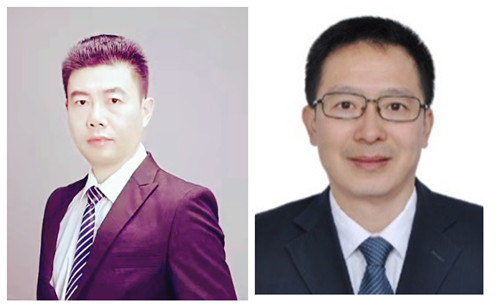
|
|
|
Perovskite Quantum Dot Photovoltaic and Luminescent Concentrator Cells: Current Status and Challenges
ZHANG Fengjuan, HAN Boning, ZENG Haibo
2022 Vol. 37 (2): 117–128
 Abstract
Abstract(
1247 )
 HTML
HTML(
90)
 PDF
PDF(6775KB)(
1628
)
Solar thermal radiant energy is abundant in storage and pollution-free, and is one of the most competitive clean energies in the future. In recent years, halide perovskite quantum dots (PQDs) are widely used in solar cells and luminescent concentrator solar cells due to their excellent photoelectric properties and unique advantages such as quantum confinement effect and solution processing, and possess vast application prospects, but they are still facing many challenges in future commercial applications. In this review, optimization strategies for improving cell performance are emphatically summarized combined with the domestic and foreign research progress in the field of PQD solar cells. The application of PQDs in luminescent concentrator cells is introduced. Finally, the current challenges in this field are elaborated, and its development trends are prospected. This review provides some ideas for the design and development of the photovoltaic technology in the future.
|
|
|
Passivation Strategies of Perovskite Film Defects for Solar Cells
WANG Wanhai, ZHOU Jie, TANG Weihua
2022 Vol. 37 (2): 129–139
 Abstract
Abstract(
804 )
 HTML
HTML(
57)
 PDF
PDF(6285KB)(
1357
)
The investigation of defects in perovskite crystals is essential to promote the development of perovskite solar cells. The defects result in non-radiative recombination as well as the deterioration of device stability. To reduce the impact of material defects on photovoltaic performance, it is necessary to deeply understand the types of perovskite film defects and the routes of suppression methods. According to electronic characteristics, defects can be divided into electron-rich and electron-deficient defects. Based on Lewis acid-base theory, electron-rich defects can be passivated by Lewis acid, and electron-deficient defects can be passivated by Lewis base or ionic liquids. These passivation additives can be added during the formation of perovskite film, or used to post-treat the surface of the films. This review summarized the defect passivation cases reported in recent years to visually present design strategies of additives and the effects of defect passivation on photovoltaic performance. Finally, developing multi-functional passivators, large-area passivation strategy and advanced charge transport layer were proposed for future perspective. This review is expected to promote the development of perovskite solar cells in the future.
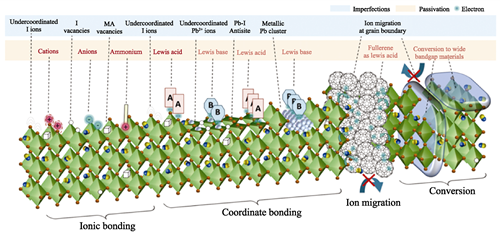
|
|
|
Metal Cyanamides/Carbodiimides: Structure, Synthesis and Electrochemical Energy Storage Performance
ZHAO Wei, XU Yang, WAN Yingjie, CAI Tianxun, MU Jinxiao, HUANG Fuqiang
2022 Vol. 37 (2): 140–151
 Abstract
Abstract(
794 )
 HTML
HTML(
51)
 PDF
PDF(12958KB)(
1099
)
Metal cyanamides/carbodiimides [Mx(NCN)y], as oxygen/chalcogenide-like compounds, are a new class of inorganic functional materials. The quasi-linear [NCN]2- anion endows their open and porous crystal structure, unique electronic structure and unique physicochemical properties. They have shown potential applications in many fields including solid-state luminescence, photo/electrocatalysis, and electrochemical energy storage, becoming a research hotspot in recent years. This review outlines the research history of metal cyanamides, introduces the crystal structures and physicochemical properties, summarizes their synthetic methods and strategies, and discusses the applications for electrochemical energy storage, focusing on the electrochemical performance and charge storage mechanism as new-type negative electrode materials for lithium/sodium ion batteries.
|
|
|
Recent Progress of Boron-based Materials in Lithium-sulfur Battery
LI Gaoran, LI Hongyang, ZENG Haibo
2022 Vol. 37 (2): 152–162
 Abstract
Abstract(
912 )
 HTML
HTML(
56)
 PDF
PDF(21542KB)(
1300
)
Lithium-sulfur (Li-S) batteries play a crucial role in the development of next-generation electrochemical energy storage technology due to its high energy density and low cost. However, their practical application is still hindered by the sluggish kinetics and low reversibility of the conversion reactions, which contribute to relatively low practical capacity, Coulombic inefficiency, and cycling instability. In this regard, the rational design of conductive, adsorptive and catalytic functional materials presents a critical pathway to stabilize and promote sulfur electrochemistry. Benefiting from the unique atomic and electronic structures of boron, boron-based materials exhibit multifarious and tunable physical, chemical and electrochemical properties, and have received extensive research attentions in Li-S batteries. This paper reviews the recent research progress of boron-based materials, including borophene, boron atom-doped carbon, metal borides and non-metal borides in Li-S batteries, concludes the remaining problems and proposes the future developing perspective.
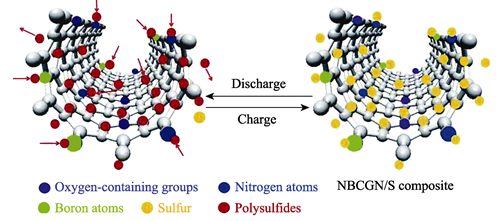
|
|
|
Research Progress on Non-noble Metal/Nitrogen-doped Carbon Composite Materials in Electrocatalytic Oxygen Evolution Reaction
FU Yongsheng, BI Min, LI Chun, SUN Jingwen, WANG Xin, ZHU Junwu
2022 Vol. 37 (2): 163–172
 Abstract
Abstract(
929 )
 HTML
HTML(
44)
 PDF
PDF(7988KB)(
1350
)
Oxygen evolution reaction (OER) suffers from four-electron transfer, sluggish kinetics and high energy requirements, limiting the development of new energy technologies such as hydrogen production from water electrolysis. In recent years, non-noble metal composite catalysts have attracted increasing attention due to their advantages of excellent catalytic activity and cost compared with noble metal-based catalysts. This review summarizes the latest progress in this field. Firstly, the OER mechanism and the evaluation methods of catalytic performance are briefly introduced. Then the non-noble metal/nitrogen-doped carbon composites are further classified into metal/nitrogen-doped carbon composites, metal single atom/nitrogen-doped carbon composites, alloy/nitrogen-doped carbon composites, and metal oxide/nitrogen-doped carbon composites. The research progress of the electrocatalysts is summarized and analyzed based on the synthesis method and catalytic activity, aiming to explore the role of nitrogen-doped carbon materials in catalyst structure and catalyst performance. Finally, perspectives are given out for the current problems and future directions of non-noble metal/nitrogen-doped carbon composites.
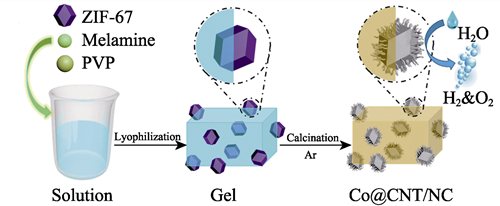
|
|
|
CoS2 as Cathode Material for Magnesium Batteries with Dual-salt Electrolytes
LI Wenbo, HUANG Minsong, LI Yueming, LI Chilin
2022 Vol. 37 (2): 173–181
 Abstract
Abstract(
678 )
 HTML
HTML(
40)
 PDF
PDF(2740KB)(
1000
)
Magnesium metal batteries (MMBs) have attracted increasing attention due to the high volume specific capacity (3833 mAh/cm3) and high safety of Mg metal anode. Nevertheless, the high polarization effect induced by Mg2+ inhibits its diffusion in solid phase and therefore limits the specific capacity of MMBs. Li+/Mg2+ dual-salt electrolyte has been proposed to circumvent the sluggish diffusion of Mg2+ in solid phase, which enables Li+ to replace Mg2+ to drive the cathode reaction. In this work, the electrochemical performance of CoS2 as conversion cathode of MMBs is studied based on different Li+/Mg2+ dual-salt electrolytes, and the effects of Li-salt concentration and discharge-charge voltage range on cycling stability are analyzed. The strategy of Li-salt additive remarkably promotes the conversion kinetics of CoS2 based MMBs. By developing charge voltage to 2.75 V, the cycling stability of Mg-CoS2 cell in LiCl-APC electrolyte is significantly enhanced. Its specific capacity can be maintained at 275 mAh/g after 150 cycles, which is much higher than that (33 mAh/g) under the protocol of 2.0 V charge voltage. It is found that the capacity degradation of MMBs is related to the irreversible reaction of CoS2 and generation of Co3S4 at the charge potential of 2.0 V. And the dissolution of Co and S elements from active species aggravates the irreversible loss of capacity. This study provides an electrochemical activation solution to the development of transition metal sulfides in conversion type MMBs.
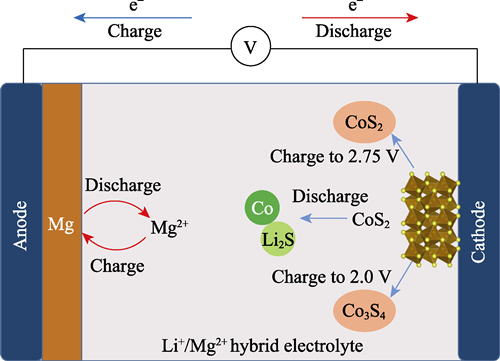
|
|
|
Flexible Binder for S@pPAN Cathode of Lithium Sulfur Battery
LI Tingting, ZHANG Yang, CHEN Jiahang, MIN Yulin, WANG Jiulin
2022 Vol. 37 (2): 182–188
 Abstract
Abstract(
563 )
 HTML
HTML(
35)
 PDF
PDF(1158KB)(
901
)
Sulfurized pyrolyzed poly(acrylonitrile) (S@pPAN) composite as cathode material of Li-S battery realizes a solid-solid conversion reaction mechanism without dissolution of polysulfides. However, its surface and interface characteristics influence the electrochemical performance significantly, and there are also obvious volume changes during electrochemical cycling. In this study, single-walled carbon nanotubes (SWCNT) and sodium carboxymethyl cellulose (CMC) were used as binder for S@pPAN cathode to regulate the surface of S@pPAN and alleviate volume changes during charging and discharging. At a current density of 2C, capacity retention rate of the batteries after 140 cycles was 84.7%, and a high specific capacity of 1147 mAh∙g-1 can still be maintained at a high current density of 7C. The ultimate tensile strength for the film of the composite binder increases by 41 times after adding SWCNT, and the composite binder guarantees a more stable electrode interface during operation, thereby effectively improves the cycle stability of the as sembled lithium-sulfur batteries.
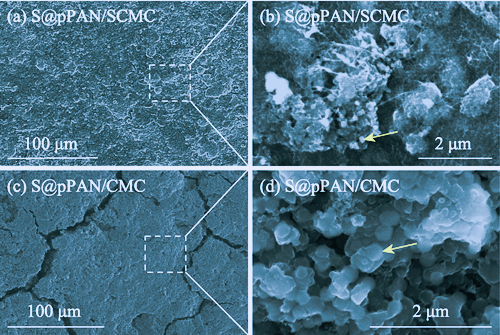
|
|
|
Na3Zr2Si2PO12 Ceramic Electrolytes for Na-ion Battery: Preparation Using Spray-drying Method and Its Property
LI Wenkai, ZHAO Ning, BI Zhijie, GUO Xiangxin
2022 Vol. 37 (2): 189–196
 Abstract
Abstract(
668 )
 HTML
HTML(
38)
 PDF
PDF(3114KB)(
1107
)
Na-ion batteries, which currently use flammable and explosive organic electrolytes, now urgently need to develop high performance sodium ion solid electrolyte to realize more safe and practical application. Na3Zr2Si2PO12 is one of the most promising solid sodium electrolytes for its wide electrochemical window, high mechanical strength, superior air stability and high ionic conductivity. But its inhomogeneous mixing of the ceramic particles with the binders causing much more pores in the green bodies makes it difficult to obtain high-density and high-conductivity ceramic electrolytes after sintering. Herein, the spray drying method was used to enable Na3Zr2Si2PO12 particles uniformly coated with binders and granulated into spherical secondary ones. The as-prepared normal distributed particles can effectively contact each other and reduce porosity of ceramic green body. After sintering, Na3Zr2Si2PO12 ceramic pellets via the spray drying show relative density of 97.5% and ionic conductivity of 6.96×10-4 S∙cm-1 at room temperature. In contrast, the relative density and room-temperature ionic-conductivity of Na3Zr2Si2PO12 ceramic pellets prepared without the spray-drying are only 88.1% and 4.94×10-4 S∙cm-1, respectively.
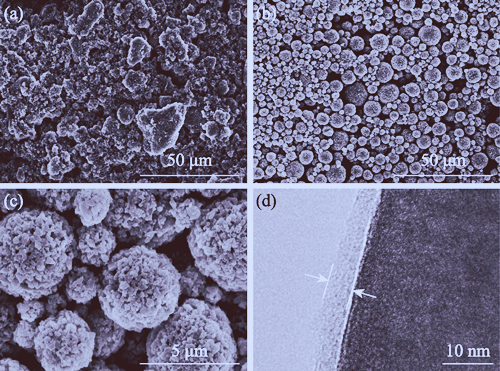
|
|
|
Application of Lead Acetate Additive for Printable Perovskite Solar Cell
MING Yue, HU Yue, MEI Anyi, RONG Yaoguang, HAN Hongwei
2022 Vol. 37 (2): 197–203
 Abstract
Abstract(
636 )
 HTML
HTML(
31)
 PDF
PDF(952KB)(
1023
)
Printable perovskite solar cells employ a device structure for which the organic-inorganic perovskite absorber is hosted by an inorganic mesoporous scaffold. Its advantages include simple fabrication process, low material cost and relatively high stability. However, it is challenging to homogeneously deposit high-quality perovskite crystals on the mesoporous scaffold. Herein, by incorporating lead acetate (Pb(Ac)2) in the typical perovskite precursor, methylamine lead iodine (MAPbI3), the crystal growth and pore-filling of the perovskite crystals in the mesoporous scaffold is improved by facilitating the crystal nucleation. Meanwhile, Ac- and MA+ form MAAc which releases during thermal annealing process, resulting in excess PbI2 in the perovskite layer which passivates the grain boundaries. By incorporating 1% molar ratio of Pb(Ac)2 in the perovskite precursor, a power conversion efficiency of 15.42% is obtained for printable perovskite solar cells. This indicates that it is feasible to enhance the performance of printable perovskite solar cells by employing additives to tune the crystallization of the perovskite absorbers.
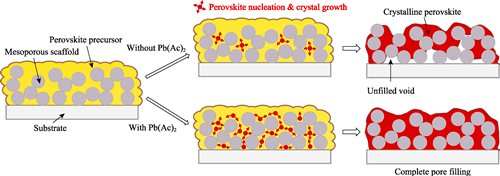
|
|
|
Thermodynamic Efficiency Limits of Semitransparent Solar Cells
JI Yongji, LIU Dong, LI Qiang
2022 Vol. 37 (2): 204–208
 Abstract
Abstract(
514 )
 HTML
HTML(
19)
 PDF
PDF(458KB)(
829
)
Semitransparent photovoltaics (STPV) is a promising solar energy harvesting technology because it can be integrated to harness huge sun-facing areas of modern buildings for electricity generation. Its thermodynamic efficiency limits are of fundamental interest. This work extended the analyses from neutral STPV for building windows to those installed on the surface of colored building envelops according to the principle of detailed balance. Results show that the efficiency limit of STPV for blue building envelops is as high as 28.3%, which represents a 10% absolute enhancement compared to the neutral STPV for building windows (18.1%). These results demonstrate that STPV can be integrated into both windows and envelops of modern buildings, which has the potential to offset the low density of solar energy. This work provides guidelines on the selection and the development of active materials for STPV.
|
|
|
Thermal and Electrcial Transport Properities of Ge Doped MnTe Thermoelectrics
LOU Xunuo, DENG Houquan, LI Shuang, ZHANG Qingtang, XIONG Wenjie, TANG Guodong
2022 Vol. 37 (2): 209–214
 Abstract
Abstract(
524 )
 HTML
HTML(
28)
 PDF
PDF(1263KB)(
861
)
MnTe is a promising candidate for the p-type lead-free thermoelectric material in middle temperature application. However, its thermoelectric performance isn’t qualified for some conventional n-type materials to form efficient thermoelectric devices. In this study, Mn1.06-xGexTe (x=0, 0.01, 0.02, 0.03, 0.04) polycrystalline block samples with different Ge doping contents were efficiently synthesized by vacuum melting quenching and spark plasma sintering. The as-obtained Mn1.06-xGexTe bulk was dense and consisted of homogeneous composition. Tiny extensive Mn can effectively restrict the formation of the second phase of MnTe2 and improve the thermoelectric properties of the matrix phase. Electrical conductivity of the materials increasing to 7×103 S∙cm-1 results from the enhanced carrier concentration 7.328×1018 cm-3 at 873 K, which contributed to a power factor of 620 μW∙m-1∙K-2 by 4% Ge doping. Meanwhile, Mn1.06-xGexTe showed the reduced thermal conductivity of 0.62 W∙m-1∙K-1 by enhanced phonons scattering intensified with point defects, realizing the effective regulation of both electrical- and thermal-transport properties. Mn1.02Ge0.04Te achieved a thermoelectric performance of 0.86 at 873 K, which evolved by 43% compared with the pristine sample.
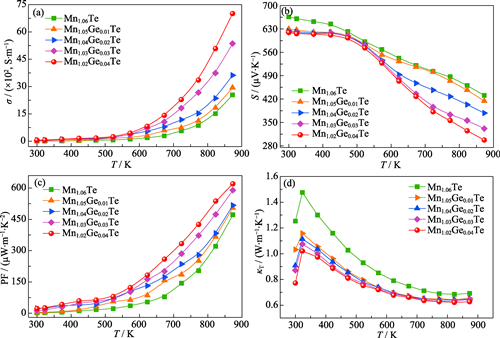
|
|
|
Defect Engineering of Graphene Hybrid Catalysts for Oxygen Reduction Reactions
JIANG Lili, XU Shuaishuai, XIA Baokai, CHEN Sheng, ZHU Junwu
2022 Vol. 37 (2): 215–222
 Abstract
Abstract(
574 )
 HTML
HTML(
28)
 PDF
PDF(2522KB)(
881
)
Oxygen reduction reaction (ORR) is important for energy and catalytic applications. Therefore, it is significant to develop highly active and selective catalysts to promote ORR. According to the reaction process, ORR can be categorized into two- and four-electrons transfer pathways. In this work, chemically modified graphene sheets with different defects were used as precursors, which were integrated with Ag-7,7,8,8-tetracyanoquinodimethane (Ag-TCNQ) to form hybrid catalysts. The ORR activities of Ag-TCNQ/high defect graphene and Ag-TCNQ/low defect graphene were compared. The results show that the electron transfer number of ORR with Ag-TCNQ/high defect graphene is 2.4. And its corresponding production yield of H2O2 is 0.62 mg/h, and Faraday efficiency is 64.45%. In comparison, the electron transfer number of ORR with Ag-TCNQ/low defect graphene is 3.7 and the corresponding half-wave potential is about 0.7 V (vs. RHE). Therefore, high structural defects promote the two-electron process of ORR, while low structural defects facilitate the four-electron process of ORR. In the composites, Ag-TCNQ nanoparticles and graphene have formed a hybrid effect to improve the catalytic activities.
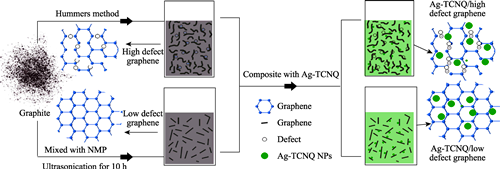
|
|
|
Thermodynamic and First-principles Assessments of Materials for Solar-driven CO2 Splitting Using Two-step Thermochemical Cycles
FENG Qingying, LIU Dong, ZHANG Ying, FENG Hao, LI Qiang
2022 Vol. 37 (2): 223–229
 Abstract
Abstract(
686 )
 HTML
HTML(
64)
 PDF
PDF(3409KB)(
1029
)
Carbon-neutral fuel production by solar-driven two-step thermochemical carbon dioxide splitting provides an alternative to fossil fuels as well as mitigates global warming. The success of this technology relies on the advancements of redox materials. Despite the recognition of the entropic effect, usually energy descriptors (enthalpy of formation or energy of oxygen-vacancy formation) were used for computational assessment of material candidates. Here, in the first step, the criteria was derived based on the combination of solid-state change of entropy and formation enthalpy, and was used to thermodynamically assess the viability of material candidates. In the thermodynamic map, a triangular region, featuring large positive solid-state changes of entropy and small enough solid-state changes of formation enthalpy, was found for qualified candidates. Next, a first-principles DFT+U method was presented to fast and reasonably predict the solid-state changes of entropy and formation enthalpy of candidate redox materials, exemplified for pure and Samaria-doped ceria, so that new redox materials can be added to the thermodynamic map. All above results highlight the entropic contributions from polaron-defect vibrational entropy as well as ionic (oxygen vacancies) and electronic (polarons) configurational entropy.
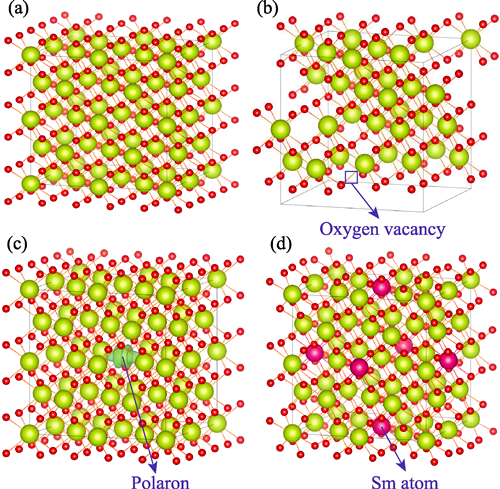
|
|
|
Amorphous LiSiON Thin Film Electrolyte for All-solid-state Thin Film Lithium Battery
XIA Qiuying, SUN Shuo, ZAN Feng, XU Jing, XIA Hui
2022 Vol. 37 (2): 230–236
 Abstract
Abstract(
726 )
 HTML
HTML(
35)
 PDF
PDF(4758KB)(
1222
)
All-solid-state thin film lithium battery (TFLB) is regarded as the ideal power source for microelectronic devices. However, the relatively low ionic conductivity of amorphous solid-state electrolyte limits the improvement of electrochemical performance for TFLB. In this work, amorphous lithium silicon oxynitride (LiSiON) thin films are prepared by magnetron sputtering as solid-state electrolyte for TFLB. With optimized deposition condition, the LiSiON thin film exhibits a high ionic conductivity of 6.3×10-6 S∙cm-1 at room temperature and a wide voltage window over 5 V, making it a suitable thin film electrolyte for TFLB. A MoO3/LiSiON/Li TFLB is constructed based on the LiSiON thin film electrolyte with large specific capacity (282 mAh∙g-1 at 50 mA∙g-1), good rate capability (50 mAh∙g-1 at 800 mA∙g-1), and acceptable cycle life (78.1% capacity retention after 200 cycles), demonstrating the feasibility of this electrolyte for practical applications.
|
|